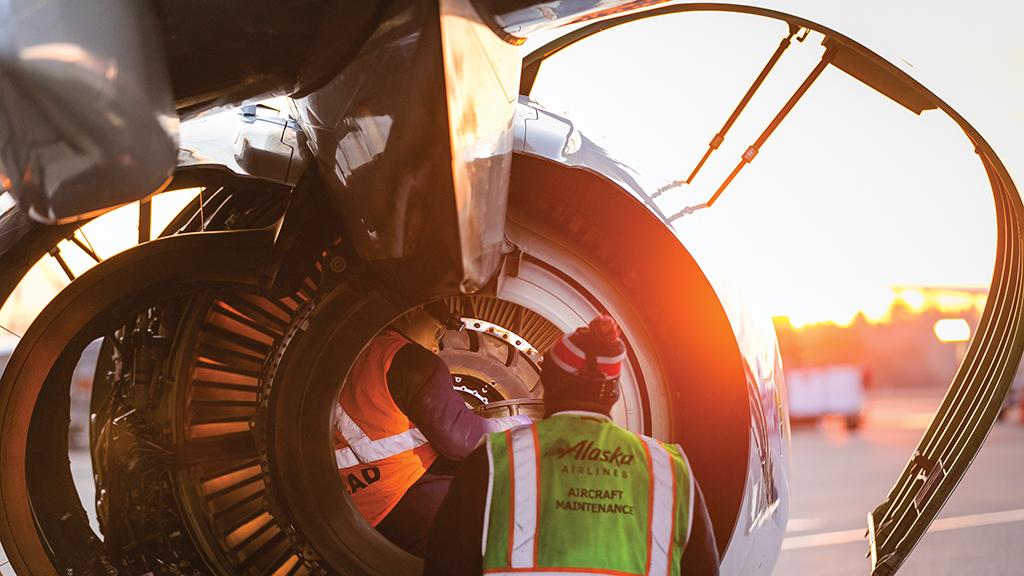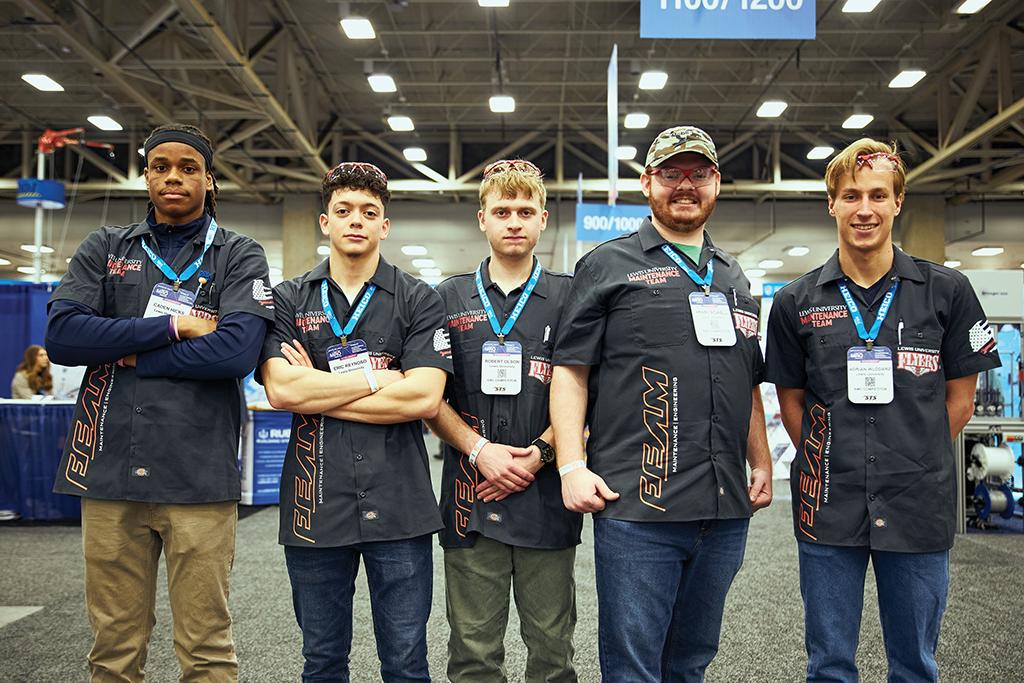Post-Pandemic Priorities Drive Shift In MRO Recruitment Strategies

North American aftermarket demand has returned as the industry moves further into recovery, but the workforce and economic flux driven by the COVID-19 pandemic have complicated a job market that was already proving tricky pre-pandemic.
To weather the storm, many companies offered early retirement or were forced to turn to layoffs and furloughs. Throughout this period of uncertainty, some workers left the industry for good, whether through retirements or transitioning to competing industries.
During a workforce pipeline panel at Aviation Week’s recent MRO Americas event, panelists from various segments of the aftermarket noted the pandemic’s lasting effects on the workforce. Panelists noted that cost-of-living increases and growing expectations of work-life balance were two areas complicating their ability to hire skilled workers.
According to Don Wright, vice president of maintenance and engineering at Alaska Airlines, the company lost “quite a few people” through leave programs, when many did not return to the airline over the course of the pandemic. However, he said “demand has come booming back,” and Alaska wants to hire approximately 300 technicians by the end of 2022 and another 200 technicians through 2024. But this may be easier said than done.
“We have seen some attrition as we are going through the new-hire process, and all of the major carriers are hiring,” Wright said. “People that are moving to a high-cost city like Seattle, for example, may take an offer from another carrier in different cities, so we’re very focused on that, too.”
Wright said this means there is a tendency to focus on hiring locally in cities like Seattle and San Francisco, where the high cost of living could prove daunting to technicians looking to switch companies. He added that technicians who are already based in these areas have structure, family and support in place, so Alaska sees higher employee retention. “That doesn’t mean that we’re not hiring from all over the country, and we have technicians all over the system, but those high costs make it really difficult for us to retain people,” he said.
Wright said that Alaska is also taking into consideration which locations might prove attractive to skilled labor when thinking about where to grow its maintenance operations. “I think that’s the opportunity for airlines to look and say, ‘Where do our technicians want to live? Where do they want to raise their families?’ That’s a big consideration. It’s not just about cost, and it’s not just about the airport authority wanting to make it happen. You have to consider all of that,” he noted.
Pratt & Whitney has been deploying a similar strategy, noted Mary Anne Cannon, vice president of the OEM’s West Palm Beach, Florida, site and development operations. “For us, being in West Palm Beach, we actually had the luxury of being a lower-cost area for quite some time and attracting people there. The pandemic has just created this housing market that’s crazy. We’re just kind of on the beginning side of that,” she said. “For us, it’s been about hiring locally, because people tend to want to stay where they were raised and raise their families, but then you have to create the pipeline.”
One MRO that has had success in recruiting workforce to a traditionally less desirable city is AAR, which nearly doubled its workforce at its Rockford, Illinois, facility during the pandemic. “Believe it or not, Rockford was not top on most people’s priority lists,” joked Ryan Goertzen, AAR’s vice president of aviation maintenance workforce development.

“One of the things the pandemic has done and accelerated is people’s unwillingness to move. I think in aviation, you’re just kind of used to moving all the time, and I think people don’t want to do that,” Goertzen said. To tackle the issue, AAR worked with state and federal legislators to create a plan for the company to use a grant from the state of Illinois and a long-term work contract with United Airlines to build the foundation for a workforce pipeline model in Rockford. It is now partnered with neighboring Eagle Rock Valley College through its EAGLE Career Pathway program to provide MRO-based curriculum and training opportunities to local students.
“It’s really going to give us the technicians we need, as well as SkyWest Airlines, which is helping us,” Goertzen said. “I think that’s a good example of where you can partner with a state with a workforce board . . . and really come up with some very innovative ways to train people who want to stay local, but they just don’t have the skills.”
Pratt’s Cannon noted that part of the success of these types of strategies comes from offering better—and earlier—training opportunities. The OEM is reaching further back to target high school-age students through opportunities such as facility tours. It has also focused recently on developing internships, which she said help to expose youth to the idea that there are attractive education and career options that don’t require four-year college degrees. “A four-year college can be daunting, mentally and financially,” she added.
Like Pratt, MRO provider FEAM is also focused on initiatives to expose younger people to aviation careers. Cam Murphy, FEAM’s president, says it is partnering with local schools and airports to provide aviation-related summer camp activities and grab attention from youth early.
“There [are] a lot of really new and innovative things going on in aviation right now, but the average consumer has no idea,” said Murphy. “Exposing them to that and being able to create programs where, during the summer, individuals can work at the airport, work with the MRO, work with the airline and be able to see the entire aerospace ecosystem” can plant a seed about potential aviation career paths, he added.
Aside from exposure to aviation career options, panelists also noted that the MRO industry has not done enough to publicize its lifetime earnings potential. “I think one of the things we need to do a better job of, especially on the maintenance side, is explaining the career path and the way that this is a six-figure career—and the fact that it doesn’t take you very long to get there,” AAR’s Goertzen said. “Yeah, maybe it’s not the first year, but by year five, I bet it’s there. I think when you talk about the career as a whole, we just haven’t done a very good job.”
Cannon emphasized that an aviation maintenance technician career path provides a particularly good salary proposition considering that it does not require a four-year degree. “In 18 months, you have an A&P license, and at Pratt you’re starting at $65,000-75,000 a year without overtime. Education assistance is there, and the path continues to grow,” she said.
“We talk a lot about STEM and encourage people to go to engineering school if that’s where their affinity is. But if that’s not their affinity, there are a lot of other paths that are very good,” Cannon continued. “We don’t talk enough in this industry about how these are very well-paying jobs for people that do a very critical skill. In my experience, a lot of the high school educators don’t realize how good these jobs are.”
At the high school level, Goertzen noted that industry stakeholders like AAR and Alaska are also targeting workforce paths through the nonprofit Choose Aerospace, which launched in 2020. The organization was involved in getting Congress to pass requirements for updating the FAA’s regulations for aviation technician education school standards, which have moved Part 147 standards away from outdated subjects and testing requirements toward modernized airman certification standards (ACS).
Goertzen says that Choose Aerospace created a new aviation high school curriculum based on the new ACS and recently ran a pilot test with a group of 12 schools across the U.S. “About 230 students have been taking this curriculum, and the idea is that this program can be deployed in 10,000 high schools across the country,” he said.
Developed through an advisory committee consisting of industry, academic and government representatives, Choose Aerospace’s aviation maintenance curriculum combines in-person learning with e-learning methods such as video lectures, e-books and augmented/virtual reality simulations to guide students toward FAA mechanic certification. The nonprofit says students have the opportunity to transfer credit from the curriculum to technical schools across the U.S.

“It’s very rapidly deployable, and it leads to a couple of things,” Goertzen said. “It leads to that credential based upon the FAA General. It will allow the student to eventually test for that general and then go straight into an airframe and powerplant school so they get time off tuition. Our push is to get Choose Aerospace in high schools all over the country on the maintenance side, similar to what AOPA did on the pilot side with the AOPA Curriculum.”
AAR and Alaska are also partnered on a workforce pipeline program that gives students the opportunity to transition into careers at both AAR and Alaska. In the Flow Through Program, which launched in summer 2021, applicants who complete three years as a technician at AAR can qualify for career openings at one of Alaska’s 14 maintenance bases. Both Goertzen and Alaska’s Wright emphasized the importance of industry collaboration—even when competing for the same talent.
“Maybe an MRO is a stepping stone into an airline, and we need to be really respectful of that relationship. Because whether it’s an MRO or a regional carrier, we’ve got to make sure that as an airline, we don’t kill the golden goose, if you will,” Wright said. “We have to work well with the regional carriers, the MROs and the maintenance providers out there to ensure that we work as a team and we make the airline maintenance business healthy, rather than just saying, ‘Hey, we’ve got the dollars, come work for us.’ If we don’t have the MRO support, we don’t operate as an airline.”




